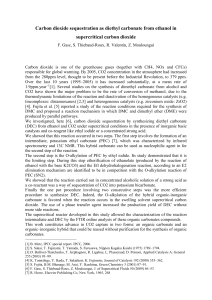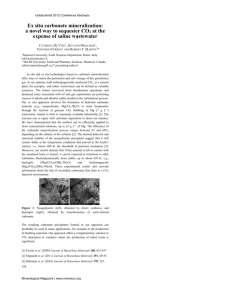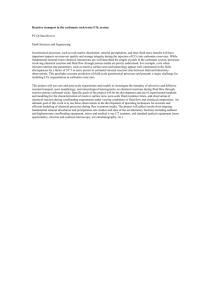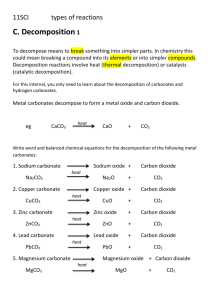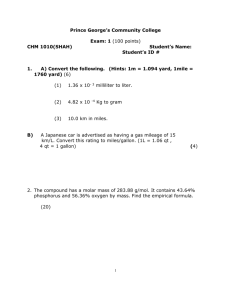Lab 4_Carbonate Analysis(1)
advertisement
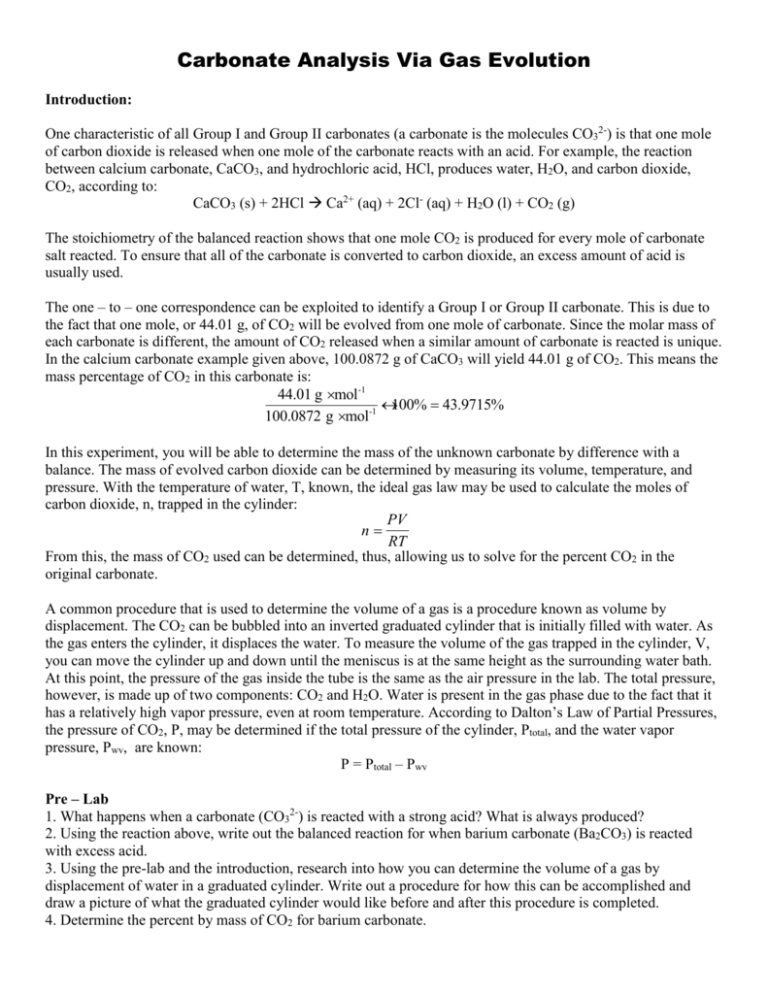
Carbonate Analysis Via Gas Evolution Introduction: One characteristic of all Group I and Group II carbonates (a carbonate is the molecules CO32-) is that one mole of carbon dioxide is released when one mole of the carbonate reacts with an acid. For example, the reaction between calcium carbonate, CaCO3, and hydrochloric acid, HCl, produces water, H2O, and carbon dioxide, CO2, according to: CaCO3 (s) + 2HCl Ca2+ (aq) + 2Cl- (aq) + H2O (l) + CO2 (g) The stoichiometry of the balanced reaction shows that one mole CO2 is produced for every mole of carbonate salt reacted. To ensure that all of the carbonate is converted to carbon dioxide, an excess amount of acid is usually used. The one – to – one correspondence can be exploited to identify a Group I or Group II carbonate. This is due to the fact that one mole, or 44.01 g, of CO2 will be evolved from one mole of carbonate. Since the molar mass of each carbonate is different, the amount of CO2 released when a similar amount of carbonate is reacted is unique. In the calcium carbonate example given above, 100.0872 g of CaCO3 will yield 44.01 g of CO2. This means the mass percentage of CO2 in this carbonate is: 44.01 g × mol-1 ´ 100% = 43.9715% 100.0872 g × mol-1 In this experiment, you will be able to determine the mass of the unknown carbonate by difference with a balance. The mass of evolved carbon dioxide can be determined by measuring its volume, temperature, and pressure. With the temperature of water, T, known, the ideal gas law may be used to calculate the moles of carbon dioxide, n, trapped in the cylinder: PV n= RT From this, the mass of CO2 used can be determined, thus, allowing us to solve for the percent CO2 in the original carbonate. A common procedure that is used to determine the volume of a gas is a procedure known as volume by displacement. The CO2 can be bubbled into an inverted graduated cylinder that is initially filled with water. As the gas enters the cylinder, it displaces the water. To measure the volume of the gas trapped in the cylinder, V, you can move the cylinder up and down until the meniscus is at the same height as the surrounding water bath. At this point, the pressure of the gas inside the tube is the same as the air pressure in the lab. The total pressure, however, is made up of two components: CO2 and H2O. Water is present in the gas phase due to the fact that it has a relatively high vapor pressure, even at room temperature. According to Dalton’s Law of Partial Pressures, the pressure of CO2, P, may be determined if the total pressure of the cylinder, Ptotal, and the water vapor pressure, Pwv, are known: P = Ptotal – Pwv Pre – Lab 1. What happens when a carbonate (CO32-) is reacted with a strong acid? What is always produced? 2. Using the reaction above, write out the balanced reaction for when barium carbonate (Ba2CO3) is reacted with excess acid. 3. Using the pre-lab and the introduction, research into how you can determine the volume of a gas by displacement of water in a graduated cylinder. Write out a procedure for how this can be accomplished and draw a picture of what the graduated cylinder would like before and after this procedure is completed. 4. Determine the percent by mass of CO2 for barium carbonate. 5. I measure an unknown carbonate of mass 5.0 g and react it with excess acid at 298 K and 1.05 atm. The volume of water that is displaced when I bubble the gas through the solution is 0.0354 L. The vapor pressure of water at this temperature is 0.031 atm. Determine the moles of CO2 that is produced in this reaction. NOTE – R = 0.0821. 6. Using the answer from question 5, determine the mass of CO2 that is produced in this reaction. Materials Available: Equipment Quantity Equipment Quantity Beaker, 600 mL 1 Graduated Cylinder, 50 mL 1 Orange Bucket with water 1 Erlenmeyer Flask, 250 mL 1 Gas Transfer Assembly 1 Thermometer 1 Hydrochloric Acid, 6 M 10 mL Unknown Carbonate 1g Procedure: 1. You will be designing and running a lab based on the information that you have researched. Based on the introduction and pre-lab material, formulate a research question that you relates to determining the identity of an unknown carbonate. Our Research Question: ________________________________________ ___________________________________________________________. 2. Based on the group that you selected and the information that you have researched, formulate a hypothesis about your research question that was formulated. Our Hypothesis: _____________________________________________ ___________________________________________________________. 3. Using the research from the pre – lab, outline a procedure below. Be sure to clearly identify which pieces of equipment (listed in the Materials section) you plan to use during your investigation. 4. Make a simple sketch showing how you plan to set up your equipment. 5. Create data tables for what you will record data on and where you will put this data. Put this is the data collection section of this handout. 6. Consult with your instructor for approval before beginning your experiment. 7. As you conduct your experiment, keep detailed written records. Be sure to list all steps taken as you perform your experiment, and all measurements and observations made during the experiment. Data Collection Data Tables: Calculations: 1. Calculate the partial pressure of carbon dioxide that was evolved: P = Patm – PH2O For the partial pressure of H2O, use the table that is on the board. 2. Calculate the moles of CO2 evolved using the ideal gas equation. 3. Calculate the mass of CO2 evolved using stoichiometry 4. Calculate the mass percent of carbon dioxide that is in the unknown sample and then use the table below to identify the unknown sample. Carbonate Percent CO2 CaCO3 43.97 K2CO3 31.84 Li2CO3 59.56 MgCO3 52.20 Na2CO3 41.52 Analysis: 1. Does your data indicate that the initial hypothesis should be accepted or rejected? Cite specific data to support your acceptance or rejection! 2. What were the inherent structural errors that were introduced as a result of your experimental design? How did these impact your final data? How can the be fixed in order to improve your results should you repeat the lab? 3. What next steps could you take in order to further investigate this topic? Cite specific areas that you believe you could study and how your data allows you to better study these areas. 4. In a well-thought-out paragraph, address the following discussion point: One possible source of error in the experiment is the presence of air bubbles in the inverted graduated cylinder or perhaps air that is trapped in the gas transfer assembly that happens to make its way to the cylinder before the carbon dioxide is transferred through it. How would the presence of this air affect the results? 5. Carbon dioxide is known to dissolve readily in water by the following reaction: CO2 + H2O HCO3- + H+ How might this impact the final results that you obtained?


